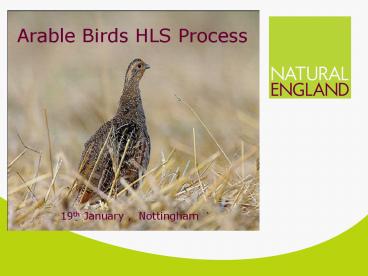Ceres House - PowerPoint PPT Presentation
1 / 16
Title:
Ceres House
Description:
To produce a simplified HLS scheme for purely arable holdings ... Corn Bunting. Reed Bunting. Skylark. Grey Partridge. Lapwing. Turtle dove. Yellow Wagtail ... – PowerPoint PPT presentation
Number of Views:44
Avg rating:3.0/5.0
Title: Ceres House
1
Arable Birds HLS Process
- Ceres House 11th August
19th January , Nottingham
2
Why do we need an arable scheme?
3
Remit of the Task and Finish group
To produce a simplified HLS scheme for
predominantly arable holdings that is easy for
the landowner to implement, with minimal
processing time for Natural England and that can
be proactively promoted as a whole package by the
FAU at landowner meetings and Farm demonstration
events
- To produce a simplified HLS scheme for purely
arable holdings that is easy for the landowner to
implement, with minimal processing time for
Natural England and that can be proactively
promoted as a whole package by the FAU at
landowner meetings and Farm demonstration events
4
Feedback from Regional Workshop Main themes
- To meet HLS targets has to focus on Farmland
birds - Pro active approach (FAU/LMAS)
- Pre application site visit advisor report
- Land owner/ Agronomist completes application
forms - Constraints map check alleviating need for full
FEP - Simplified consultation process with short turn
around - Pre set prescriptions and indicators reducing
genesis processing time
5
Outline of the Simplified Process
- This process is solely intended for use on
predominantly arable holdings that otherwise
would have insufficient features to qualify for a
normal HLS - If Cross checking and site visits reveal any
important features such as SSSI, SAMS, other
important archaeology or BAP habitats (except
hedgerows) the applicant must be directed to a
full HLS application and FEP. - To comply with the Natural England policy on HLS
and farmland birds, the Scheme will be targeted
to holdings with 3 or more of the big 6 found in
the surrounding 2 km. However should the holding
also have populations of any of four other
species of regional importance then there will
also be additional management options available
for these. - The applicant agrees to implement a suite of pre
set options on the holding, taking advice from a
Natural England officer who will recommend which
options are suitable, based on the farmland bird
species found in the local area. Each suite of
options is designed to maximise the benefits for
particular target bird species.
6
Outline of the Simplified Processcont
- The process will be simplified as much as
possible to enable the land manager themselves to
complete the application and FEP (therefore the
only information required in the FEP will be
records of birds on the holding which can be
pre-supplied by Natural England), and there will
be a fast track approach to minimise the time it
takes process an agreement whilst still meeting
all statutory obligations and audit conditions. - We have to ensure that the simplified process
still meets Natural England targets. Therefore by
agreeing to the process the applicant will need
to undertake sufficient work to meet the criteria
for entry into the scheme under the Farmland
Birds theme. - Although nominally targeted toward farmland birds
the suites of options will in many cases also
benefit invertebrates and/or rare arable plants.
Once agreements are established they can modified
as normal to bring benefit to other wildlife or
include new capital items. - All HLS agreements will still need to be
underpinned by an ELS agreement which should set
up in the usual way. Where ELS options are chosen
Natural England will provide supplementary
management advice.
7
What it is not -
- A new HLS scheme in its own right
- An attempt to circumvent tried and tested
prescriptions or indicators by creating
prescriptions from scratch - A way of bypassing the new HLS targeting system
8
All suites of prescriptions and indicators used
in the simplified process are already available
in Genesis. They have simply been modified where
advisor discretion is allowed in any agreement
(i.e. the bits in square brackets ) to maximise
the benefits to specific target species.
Summary
9
Simplified HLS Process
Prepare and send out Application pack
Pre- FEP 1.Consult webmap for bird species 2.
Carry out site visit 3. Check for SAMs and other
obvious historic features 4. Check for BAP
habitat 5. Check for SSSI 6. Ask about birds on
the holding 7. Determine if arable/ normal HLS
is more appropriate 8. Discuss pre generated
options with Landowner
Complete forms FEP reduced so the only
information That needs to be recorded is
presence Of bird species
Check environmental Information map
Request application Pack
Scanning and data Input to Genesis
Finalise Pre-set options Choice and enter
into Genesis
Send out HE consultation (10 days)
BAP habitat SAMs Historic features SSSI
Produce agreement maps on GIT
HER consultation or Environmental
information Map reveal important Features
Discuss with Land owner
Finalise agreement
Sign and return
Carry out Normal HLS Application process
Local teams/ FAU/ partners
Landowner / agent
ISS
Local teams
10
Arable Birds HLS
Linnet
Tree Sparrow
Corn Bunting
Reed Bunting
Skylark
The East Midlands Regional Ten
Grey Partridge
Lapwing
Turtle dove
Yellow Wagtail
Yellow Hammer
11
(No Transcript)
12
Landowner Guidance
13
Example Prescriptions and Indicators (1)
14
Example Prescriptions and Indicators (2)
15
Example Prescriptions and Indicators (3)
16
Next steps
- Prescriptions and indicators will be completed by
the end of November. - The pre-set prescriptions and indicators will be
passed to RSPB, both locally and nationally and
Natural England specialists for comment and sign
off. - A 6 month pilot will be rolled out in the
Lincolnshire Fens and Sherwood. - At the end of this period the scheme will be
evaluated and any amendments made before rolling
out region wide.































